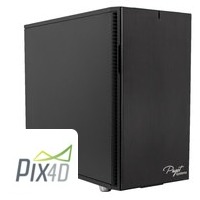Table of Contents
Introduction
Here at Puget Systems, specifically in the Labs department, most of the content that we write falls into one of two categories: either long, fairly in-depth articles looking at the performance of various PC components in a given application or recommended system pages, with multiple configuration options aimed at different budgets and lots of supporting data drawn from the aforementioned articles. For some readers all of that is information overload, though, and they just want a quick question answered: what is the best computer for my needs? We’re going to try answering that question more directly in a new series of short articles, like this one.
Today we are looking at Pix4D, a photogrammetry application which can be used to generate 3D models of objects, buildings, or even huge maps from sequences of digital photos. It uses the CPU for most of the heavy lifting, but also benefits from a CUDA-compatible graphics card, and can have hefty memory space and drive capacity / speed requirements when working with large image sets.
Good PC Configuration for Pix4D
We'll start off with a good, solid workstation design for Pix4D – without too high of a price tag. This application performs best with a CPU that has a combination of high clock speed and fairly high core count, which means that AMD's latest generation of Ryzen and Threadripper processors do very well here. The 12-core Ryzen 9 5900X showed solid performance in our last round of CPU testing, coming in near the top of charts while costing far less than the models that were faster. To go along with that chip, 64GB of memory will usually be sufficient for projects up to 1,000 images or more. Pix4D also makes use of the video card, but there isn't a wide range of performance there so any high-end GeForce model will do well enough.
| CPU | AMD Ryzen 9 5900X 12-core |
| Video Cards | NVIDIA GeForce RTX 2060 6GB |
| RAM | 64GB DDR4 |
| Drives | 500GB & 1TB NVMe SSDs |
Configure System With These Specs
Better PC Configuration for Pix4D
Stepping up to the top model in AMD's Ryzen 5000 Series, we have the 16-core Ryzen 9 5950X. It turned in the top performance result across all four of the image sets in our public Pix4D benchmark, scoring 5 to 10% better than the 5900X, and thus it should be the fastest CPU currently available for working with up to ~1000 photos per project. To ensure that memory doesn't become a bottleneck, we'd also advise 128GB of system memory – along with more drive capacity for storage. And just to be safe, a newer and more powerful video card is worth considering too, in case folks are using any other applications which are more GPU dependent. Protecting the investment in all of this hardware with an extended parts warranty can be a wise choice as well.
| CPU | AMD Ryzen 9 5950X 16-core |
| Video Cards | NVIDIA GeForce RTX 3070 8GB |
| RAM | 128GB DDR4 |
| Drives | 500GB & 2TB NVMe SSDs |
Configure System With These Specs
Best PC Configuration for Pix4D
While projects measured in the hundreds of photos will process most quickly on an AMD Ryzen 5000 Series processor, we have done some limited testing with image sets with thousands of photos – and in that range, higher core count chips like AMD's Threadripper models perform slightly better. These models also support more system memory, which can be important when working with such projects. Based on everything we have gleaned from our testing, the 32-core Threadripper 3970X is the best choice for dealing with these larger image sets. Alongside that, we recommend increasing the RAM, the speed of the SSDs where projects are kept, and the total drive storage capacity in the system too.
| CPU | AMD Threadripper 3970X 32-core |
| Video Cards | NVIDIA GeForce RTX 3080 10GB |
| RAM | 256GB DDR4 |
| Drives | 1TB & 2 x 2TB NVMe SSDs |
Configure System With These Specs
Depending on your exact needs, you might not need that much drive capacity – or you could need even more! Such things are entirely up to personal preference, so please feel free to configure any of these to better fit your specific situation. We also have some limited evidence suggesting that the Threadripper 3990X can be even better than the 3970X when working with extremely large image sets… but in all of our standard testing the 3970X beat it, and in our experimental tests they pretty much ended up neck and neck. It also costs a lot less, so even if the 3990X is a few percent faster in specific situations that may not justify the massive increase in price.
Additional Resources
If you want to know more about Pix4D performance, we have published several articles over the years looking at how various CPUs and video cards compare when processing different image sets. We also have public benchmarks that you can download and run on your own system to see how it stacks up with the latest hardware. And if you aren’t sure what you need, or if your workflow includes multiple applications, please feel free to call or email our consultants to get a more personalized configuration.
Puget Systems offers a range of powerful and reliable systems that are tailor-made for your unique workflow.

